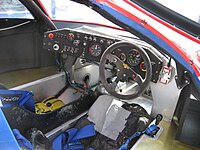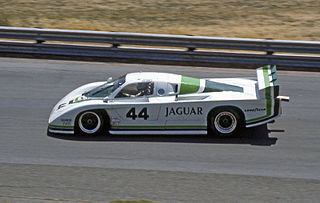
Bill Adam is a Canadian racing driver born in Airdrie, North Lanarkshire, Scotland.
Krohn Racing is a professional sports car racing team based in Houston, Texas. The team competes in the IMSA TUDOR United SportsCar Championship Prototype class, and has competed in the FIA World Endurance Championship, Intercontinental Le Mans Cup GTE-Amateur class; the American Le Mans Series GT2 class; and the Rolex Sports Car Series Daytona Prototype class.

The Porsche 962 is a sports prototype racing car designed and built by Porsche. Created to replace the Porsche 956, 962 was introduced at the end of 1984 and replaced the 956 in the IMSA's GTP class in 1985 due to regulation changes obsoleting the 956. It was also introduced in the World Sportscar Championship's Group C category in 1984. Over its decade-long career, the car in its Group C form won the 24 Hours of Le Mans twice, with a derivative of the car, the Dauer 962 Le Mans, winning a further title in 1994. In total, the 962 scored nineteen total constructor's championships across various series. The 962's successor was the Porsche WSC-95, introduced for the 1996 24 Hours of Le Mans, but did not receive factory backing or support.

Alvah Robert "Al" Holbert was an American automobile racing driver who was a five-time champion of the IMSA Camel GT series and the fifth driver to complete the informal triple Crown of endurance racing. He once held the record with the most IMSA race wins at 49.

The 1989 24 Hours of Le Mans was the 57th Grand Prix of Endurance, taking place at the Circuit de la Sarthe, France, on the 10 and 11 June 1989. This year it was not included as a round of the 1989 World Sports-Prototype Championship. The entry list promised a strong contest between five manufacturers. Jaguar had won in 1988 and went on to win the championship; while Sauber had finished second and was now matching Jaguar on the track. New regulations were coming in 1991, and the first examples of the 3.5-litre normally-aspirated formula were entered by Spice Engineering.
John Lee Paul Jr. was an American racing driver. He competed in CART and the Indy Racing League competitions, but primarily in IMSA GT Championship, winning the title in 1982.
Dyson Racing is a professional sports car racing team based in Poughkeepsie, New York in the United States. Founded by Rob Dyson in 1974, the team competed successfully in North American sports car racing series, including the IMSA GT Championship and American Le Mans Series.

Spice Engineering was a British racing team founded by driver Gordon Spice with Raymond Bellm in the early 1980s, later becoming a successful sports car constructor in 1986. They competed in the World Sportscar Championship in Europe as well as the IMSA GT Championship in North America, at times partnering with major manufacturers such as General Motors and Honda as well as race engine manufacturer Comptech.

IMSA GT was a sports car racing series organized by International Motor Sports Association. Races took place primarily in the United States and occasionally in Canada.

The Chevrolet Corvette GTP was an American Grand Touring Prototype-class sports prototype racing car which successfully participated in the IMSA Camel GT from 1984 until 1989. The car was professionally fielded in competition as General Motors' Chevrolet Corvette C4 official factory team effort in the IMSA GTP class.
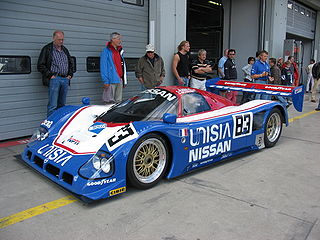
The Nissan R90C was a platform used for Group C racing cars built in 1990 by Nissan Motors for competition in World Sportscar Championship (WSC) based in Europe and the All Japan Sports Prototype Championship (JSPC). The cars based on the basic R90C platform would compete until 1993 before Nissan chose to withdraw from sports car racing, not returning until 1997. It won three JSPC championships and several significant endurance races during its career.
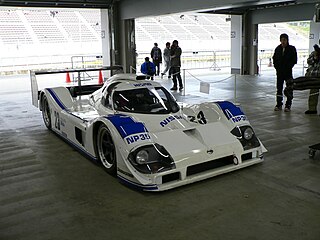
The Nissan P35 was a planned Group C car built by Nissan Motors for competition in the World Sportscar Championship. Developed by Nissan Performance Technology Inc. (NPTI), which had formerly raced under the name Electramotive in the United States, the cars were intended to be completed by the middle of 1992, with competition starting in 1993. However economic troubles for Nissan led to the cancellation of the project soon after testing of the first cars had begun, meaning that the P35s never raced.

The Nissan NPT-90 was a racing car developed in 1990 for Nissan Motors by Nissan Performance Technology Incorporated (NPTI), formerly known as Electramotive Engineering. It was a replacement for the highly successful GTP ZX-Turbo that had won the IMSA GT Championship in 1989. The NPT-90 would go on to win the championship in 1990 and 1991 before being retired by Nissan at the end of the 1992 season.
The 1990 Camel GT Championship season was the 20th season of the IMSA GT Championship auto racing series. It consisted of GTP and Lights classes of prototypes, as well as Grand Tourer-style racing cars which ran in the GTO and GTU classes, as well as a tube-frame All-American Challenge (AAC) class during select GT-only rounds. It began on February 3, 1990, and ended November 11, 1990, after twenty rounds.
Jeremy Dale is a Canadian racing driver. His career in motorsports has spanned more than 30 years as a racer, television commentator, race series director, race team president, and race team owner.

The Lola T600 was a racing car introduced in 1981 by Lola Cars as a customer chassis. It was the first GT prototype race car to incorporate ground-effect tunnels for downforce. The revolutionary aerodynamic design of the T600 was widely imitated throughout the 1980s by International Motor Sports Association (IMSA) and Group C prototype cars. The Lola T600 ran initially in the U.S.-based IMSA GT series and later in European Group C races.

The Intrepid RM-1 is a sports prototype racing car designed in 1991 by Bob and Bill Riley and built by Pratt & Miller to IMSA GTP specifications. Powered by a Chevrolet V8 engine, it was campaigned variously by Jim Miller, Prototype Technology Group and Wayne Taylor in the IMSA Camel GT from 1991 through 1993. Though it won only one race in its three seasons of competition, the shovel-nosed Intrepid was notable for the extreme—and at one point, disastrous—levels of downforce it generated, giving it the highest cornering speeds of any prototype of its era. The car's development was set back by a devastating 1991 crash at Watkins Glen that critically injured driver Tommy Kendall, and the program never fully recovered.
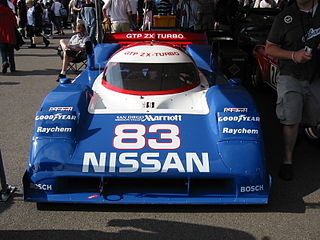
The Nissan Present the 39th Annual 12 Hours of Sebring International Grand Prix of Endurance, was the third round of both the 1991 Camel GT Championship and Exxon Supreme GT Series and was held at the Sebring International Raceway, on 16 March.

The March 86G was a Group C and IMSA GTP sports racing car built by March Engineering. Built as simply a chassis with no engine, it was branded as one of three cars, the BMW GTP, the Buick Hawk or the Nissan R86V depending on which engine was placed in the chassis and which team was running it. There were a number of subtle bodywork changes to reflect the manufacturer which ran the car.
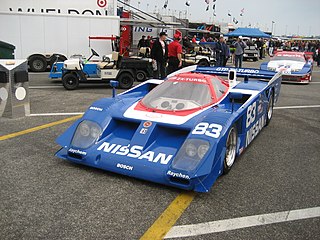
The 12 Hours of Sebring Grand Prix of Endurance, was the third round of the 1989 IMSA GT Championship and was held at the Sebring International Raceway, on March 18, 1989. Victory overall went to the No. 83 Electramotive Engineering Nissan GTP ZX-Turbo driven by Chip Robinson, Geoff Brabham, and Arie Luyendyk.



